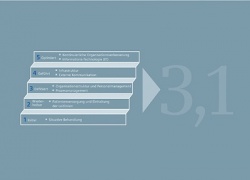“Act on Stroke“: Siemens presents a new consulting concept for optimized stroke care
The Siemens sector Healthcare has developed the new consulting model “Act on Stroke”, tailored specifically to clinical workflows in the treatment of stroke. Following models for industry processes, an expert team from Siemens evaluates the maturity level of clinical processes in a hospital.

Based on a data pool that integrates the knowledge of leading hospitals worldwide, Siemens consultants support the optimization of clinical workflows, aiming at measurably higher quality of care for stroke patients. At Medica 2010, Siemens presents the new approach and first consultation projects with “Act on Stroke”.
“Time is Brain” is a key principle in neurology and expresses the importance of time with respect to stroke care: the quicker a patient is diagnosed and treated appropriately, the greater the probability that he may recover from possible brain damage. However, the processes and guidelines for optimal stroke care are not maintained consistently. In Europe, less than 40 percent of the hospitals meet the minimum standards for stroke care.1 In Germany, only approximately half of the stroke patients are treated in a stroke unit, that is, a specialized stroke ward.2 And in the USA, only 4.3 percent of patients with a cerebral infarct receive timely thrombolytic treatment3 – the current stroke therapy that dissolves the blood clot (thrombus) causing reduced blood supply to the brain.
With "Act on Stroke“, Siemens has developed a new consulting concept for improved stroke care management. The model integrates the analyses of processes from hospitals leading the field of stroke care worldwide and combines them with medical guidelines and current scientific results. “Act on Stroke” is backed by an interdisciplinary expert team from Siemens: physicians, strategy and workflow consultants, as well as economists, IT experts, engineers, and medical technicians.
In only five days, two of the Siemens consultants analyze the stroke processes in a hospital. Based on more than 450 individual criteria, they determine the maturity level of complex clinical processes on a scale from 1 to 5. After having evaluated the status quo and provided a detailed report, the consultants develop actions for the customer that enable workflows to be both measured and sustainably optimized with respect to time and adherence to guidelines. For example, thrombolytic therapy should be started no later than four and a half hours after onset of the first symptoms.
Siemens has yet successfully applied “Act on Stroke” to several customer sites, among them the University Clinic of Muenster, Germany, where Professor Bernd Ringelstein, MD, heads the Clinic and Polyclinic for Neurology. “Siemens analyzed the stroke processes at our hospital in a very impressive and convincing way. The recommended actions will help us to overcome residual obstacles within our processes efficiently,” says Ringelstein. Siemens aims to complete the “Act on Outcomes” program by adding other relevant areas of care, for example, the treatment of cardiac insufficiency. So far, the model has been developed for stroke and for acute coronary syndrome.
18.11.2010











